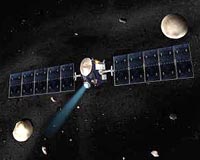 |
Sacramento CA (SPX) Jun 30, 2010 Aerojet, reports that its innovative ion propulsion engine - built in partnership between Aerojet and NASA's Glenn Research Center - has completed a test series encompassing the requirements of a wide range of ambitious space missions, including the recently announced Flagship Technology Demonstrator first mission (FTD-1). The thruster was developed under NASA's Evolutionary Xenon Thruster (NEXT) program as the next generation beyond the ion engines now propelling the Dawn spacecraft to a pair of asteroids. The NEXT engine has been in operation for more than 30,000 hours at NASA's Glenn Research Center in Cleveland, Ohio. By providing a small, constant thrust over long periods of time, the thruster accelerates spacecraft to thousands of kilometers per hour - all while using less than a tenth of the propellant of a conventional, chemically based rocket. Such efficiency will allow spacecraft to reach more interesting and more difficult scientific targets throughout the solar system. With NASA now considering human flights to asteroids and even Mars, this critical capability greatly reduces the amount of propellant that must be used for a launch. "When we take humans to Mars, we will leverage advances in technology like this," said Mike Patterson, NEXT principal investigator and senior propulsion technologist at Glenn Research Center. "The NEXT system occupies a prominent place in our phased infrastructure development plan for Martian exploration, and is being considered for a flight experiment on future NASA Flagship missions." In operation, the xenon ions are accelerated to speeds of up to 40,000 meters per second, making NEXT the latest and by far the most powerful in a class of high-efficiency ion thrusters propelling spacecraft on several science missions. However, this is little noticed outside the advanced space propulsion community. NASA's Glenn Research Center manufactured the test engine's core ionization chamber. Aerojet designed and built the ion acceleration assembly, which is key to the long life and high performance of the thruster. This acceleration assembly has more than 25,000 holes precisely etched in a pair of thin plates 20 inches across, but separated by only a few thousandths of an inch. These plates must maintain their precise alignment and spacing while operated at high voltage and high temperatures. "This is an incredible feat of engineering by our designers, building on decades of experience at NASA," said Andy Hoskins, Aerojet's technical principal for Electric Propulsion. "The performance of this engine demonstrates the breadth of Aerojet's capabilities and its commitment to provide the highest quality propulsion systems for any space mission." The NEXT project is a joint technology and engineering development program led by NASA Glenn to develop a next generation electric propulsion system, including power processing, propellant management and other components.
Share This Article With Planet Earth
Related Links Aerojet Rocket Science News at Space-Travel.Com
 NASA interplanetary spacecraft sets record
NASA interplanetary spacecraft sets recordPasadena, Calif. (UPI) Jun 8, 2010 NASA says its ion-propelled Dawn spacecraft - en route to explore two of the asteroid belt's most massive objects - has set a record for velocity change. Officials said the record previously held by NASA's Deep Space 1 - the first interplanetary spacecraft to use ion propulsion - fell Saturday when Dawn's accumulated mission acceleration exceeded 4.3 kilometers per second - 9,600 m ... read more |
|
| The content herein, unless otherwise known to be public domain, are Copyright 1995-2010 - SpaceDaily. AFP and UPI Wire Stories are copyright Agence France-Presse and United Press International. ESA Portal Reports are copyright European Space Agency. All NASA sourced material is public domain. Additional copyrights may apply in whole or part to other bona fide parties. Advertising does not imply endorsement,agreement or approval of any opinions, statements or information provided by SpaceDaily on any Web page published or hosted by SpaceDaily. Privacy Statement |